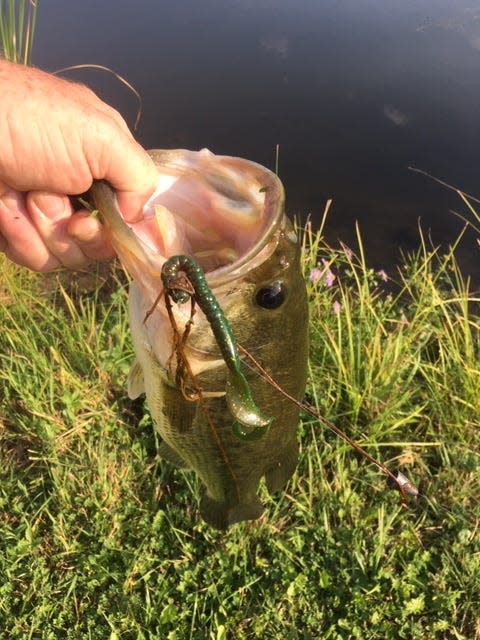These fishing tips and tricks will help you catch bass from the shore
Though fishing for bass from a boat has become somewhat the norm now, many largemouth and even smallies (smallmouth bass) can fall to shore-side anglers using those bassin’ tactics honed on the water.
Some of the techniques we learned on the lakes while in a boat can easily be transferred to successful strategies when we find ourselves on foot at the edge of a pond, river, or on a dock.
Landside bass fishing can offer the boat-less a new and different piscatorial challenge — on a dock at a summer party, at a pond, or lakeside while at a family cookout.
Fishing with a bunch of kids might all of a sudden be on the agenda, too.
And we still have to catch bass.
But how does a bass fisherman, used to fishing from a boat, and now without all the necessary gear — such as a trolling motor, a depth (fish) finder, a stocked rod locker, and a boat to take us from one choice spot to another — still catch fish?
Instead of a below-the-deck rod locker, stuffed with rods and reels, rigged with different baits for specific applications, and tackle boxes that would give a weightlifter a hernia, we find ourselves having to scale back and down to the bare bones to fish from the shore for bass.

If there was only one rod and one bait to use, a six- to eight-inch plastic worm is always a good bet. A plastic bag can easily carry a number of colors; the first choices being purple, black, blue, pumpkinseed, and motor oil green. (Make sure you don't leave various colored plastic worms in the bag very long because they may discolor each other as the colors bleed.)
A good way to rig a worm is "Texas style." That is, take the hook, (a sharp 4.0 works well) and push the point down through the head of the worm, about a quarter inch, to one-half inch, and then push it out the side of the worm. Pull the hook through, so the head of the worm is covering the knot, at the hook's eye. Then stick the sharp part of the hook through the body of the worm so that the artificial worm hangs straight. A straight hanging worm is more important than one would think. It does make a difference.
Two rods are better than one, and just as easy to carry. A good second choice is to tie on a white, three-eights ounce spinner bait. I like a heavy bass rod to toss a spinner bait, usually a "medium-heavy" or "heavy," at least six-and one-half feet in length.
More: Experimenting with different mayflies for trout can equal success on the water
When hiking back in to a pond, two rods are easy to carry, along with a little tackle box, full of an assortment of spinnerbaits, worms, extra hooks, line clippers, and extra worm hooks.
I like throwing a spinnerbait around the pond or off the dock first.
The spinnerbait seems to pick up the active fish, and there are usually a few hungry bass around any pond that can't resist a spinnerbait reeled in just a few inches below the surface. Many pond bass have never seen a spinnerbait before and hit it without hesitation — sometimes rocketing out of a hideout in the bank, or weeds, making a V-shape in the shallow water.
Cast the spinnerbait out into clear water, next to weeds and reel it in at a slow, steady pace so that the spinners can work their magic and call up Mr. Bass.
After probing the available water with the spinnerbait first, and the action cools down, pick up the worm rod with the aforementioned Texas rig setup and fish slowly for the more inactive, stubborn bass. If one worm color is not working try a different color. On certain days, different colors work better than others.
Try different retrieval and presentation techniques. Most of the time, bass like a slow presentation with a worm, so cast it out, then lift it, reel a couple times, let it sink, lift it off the bottom again, crank the reel a couple more turns, lift it again, and so on.

Once in a while bass seem to like a faster presentation, and the worm can be reeled in like a spinner. Other times, if there is surface vegetation like duckweed or lily-pads, bass may prefer to dine up on the surface. The Texas-rigged worm can be "swum" through the floating algae or duckweed, as it is quite weedless with the buried hook’s point. And surface blowups make for an exciting time.
Speaking of top-water, a couple jitterbugs, or floating frogs, are worth the extra space in the little tackle box if fish are in the mood, especially in the evening or early morning. Fish them on the same rod as the spinnerbait. Fish the jitterbug through clear water and the frog across the floating vegetation.
More: This bill bans some hunting competitions in New York. What's included, exempt
Bass fishing has continued to evolve in the last few decades on the big water, and those techniques we refined on the lakes while on the deck of a bass boat can be successfully applied back in the woods, or off a dock, too.
And one tip: It doesn't cost any more to set the hook on a pond than it does a lake. So set the hook when Mr. Bass runs with your worm like you mean it.
— Oak Duke writes a weekly column.
This article originally appeared on The Evening Tribune: Oak Duke column: Follow these tips to catch bass from the shore
